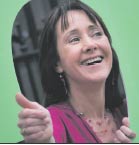Greens and Leaders

The Green Party is uneasy with the idea of ‘leaders' and certainly with the consolidation of ‘leadership' status and ministerial office.
The Greens are awkward about leadership. For years there was no “leader”. The party eschews the categorisation of “leaders and followers”, the members are leaders as well as followers. It fits with one of the four “pillars” of the Green movement, grassroots democracy (the other “pillars” being environmentalism, non-violence and social justice).
It was the media that insisted the Greens appoint a “leader” – its agenda demands such hierarchies and the Greens capitulated. But the very scepticism of the Greens to the idea of “leaders” may open the way for some one other than one of its two government ministers, to become “leader”. Ciaran Cuffe, who is disappointed at losing out on ministerial office (he had expectations of being a cabinet minister), is an obvious contender but, at the time of writing, he has given no indication of a willingness to stand.
Many in the party perceive Eamon Ryan (44) as the most accomplished and presentable performer but he has ruled himself out, as yet, and his appointment as Minister for Communications, Energy and Natural Resources may preclude him.
Cabinet office could also be a problem for John Gormley but he is a favourite as of the time of writing. His success against Michael McDowell in Dublin South East will have won him the gratitude of many left-leaning Greens. He is younger than he looks (he will be a mere 48 on 4 August this year). Born in Dublin, he was educated at St Munchin's College, Limerick, UCD and Freiburg University in Germany.
He ran an academy of European languages before becoming a full time politician. He fought his first general election in 1989. In 1991 he was elected to Dublin City Council and was Lord Mayor of Dublin in 1994-1995. He was elected to the Dáil in 1997, depriving Michael McDowell of his seat then by just 27 votes. He retained his seat in 2002 and 2007. It was he who campaigned within the party for the election of a leader in 2002. He lives in Ringsend with his wife, Penny, and their son and daughter.
The only other declared contender for the leadership is the former MEP for Dublin, Patricia McKenna. She is slightly older than John Gormley (she was 50 on 13 March last). She was adviser to the first Green TD in Ireland, Roger Garland (he held a seat in Dublin South from 1989 to 1992). She was elected to the European parliament in 1994 and again in 1999 but was defeated in 2004. She is best known for her opposition to the use of Shannon by US troops engaged in the war in Iraq (John Gormley was equally as vocal as the Green spokesperson on foreign affairs from 2002). She is opposed to nuclear power and genetically modified crops.
 She failed to get elected to the Dáil for Dublin Central in the recent election.
She failed to get elected to the Dáil for Dublin Central in the recent election.
Government for the Greens is certain to be challenging. Aside from the huge compromises made on policy – essentially the programme for government is a rehash of the Fianna Fail election manifesto – the week-to-week grind of collective responsibility will prove wearying, once the initial excitement of office wears off.
The repeated demands to support policies they oppose and the indignity of having to vote down motions carefully honed by the opposition to embarrass them will prove trying, perhaps especially for John Gormley, who is less temperamentally suited to compromise than is Eamon Ryan. Their inexperience of government and of the rigours of compromise may prove difficult also.
However both will be heartened by the (near?) demise of the Progressive Democrats. John Gormley's seat was most threatened by Michael McDowell, and his retirement from public life will ease his position in Dublin South East (John Gormley was elected first in 1997 at the expense of Michael McDowell and only in 2002 did both retain their seats and that was due to the collapse of Fine Gael). Similarly in Dublin South, Eamon Ryan's position is eased by the retirement of Liz O'Donnell, although he must be worried about the prospect of a resurgence of Labour in the constituency.
The reality is, however, no Green TD has a safe seat, aside from Trevor Sargent who has forsaken the leadership.
The four “pillars” were formulated by the German Greens in 1979-1980. The German Greens were in the federal government of Germany, with the Social Democratic Party from 1998 to 2005 and its example was an important influence on the overwhelming decision of the Irish Greens to enter government now.
 The German Greens made a principle of its opposition to nuclear power – oddly within a day or two of taking office, one of the two Irish Green ministers, Eamon Ryan, was encouraging a debate on nuclear power for Ireland. The German Greens supported the war on Afghanistan after 9/11 but, as with the majority of the German people, opposed the invasion of Iraq.
The German Greens made a principle of its opposition to nuclear power – oddly within a day or two of taking office, one of the two Irish Green ministers, Eamon Ryan, was encouraging a debate on nuclear power for Ireland. The German Greens supported the war on Afghanistan after 9/11 but, as with the majority of the German people, opposed the invasion of Iraq.
It was in Finland that the Greens first came to government office in Europe, when the Green Party there joined a national c abinet. Since then the Greens have been in coalition governments in Belgium, France and the Netherlands. In Latvia, a Green candidate became Prime Minister in 2004.
